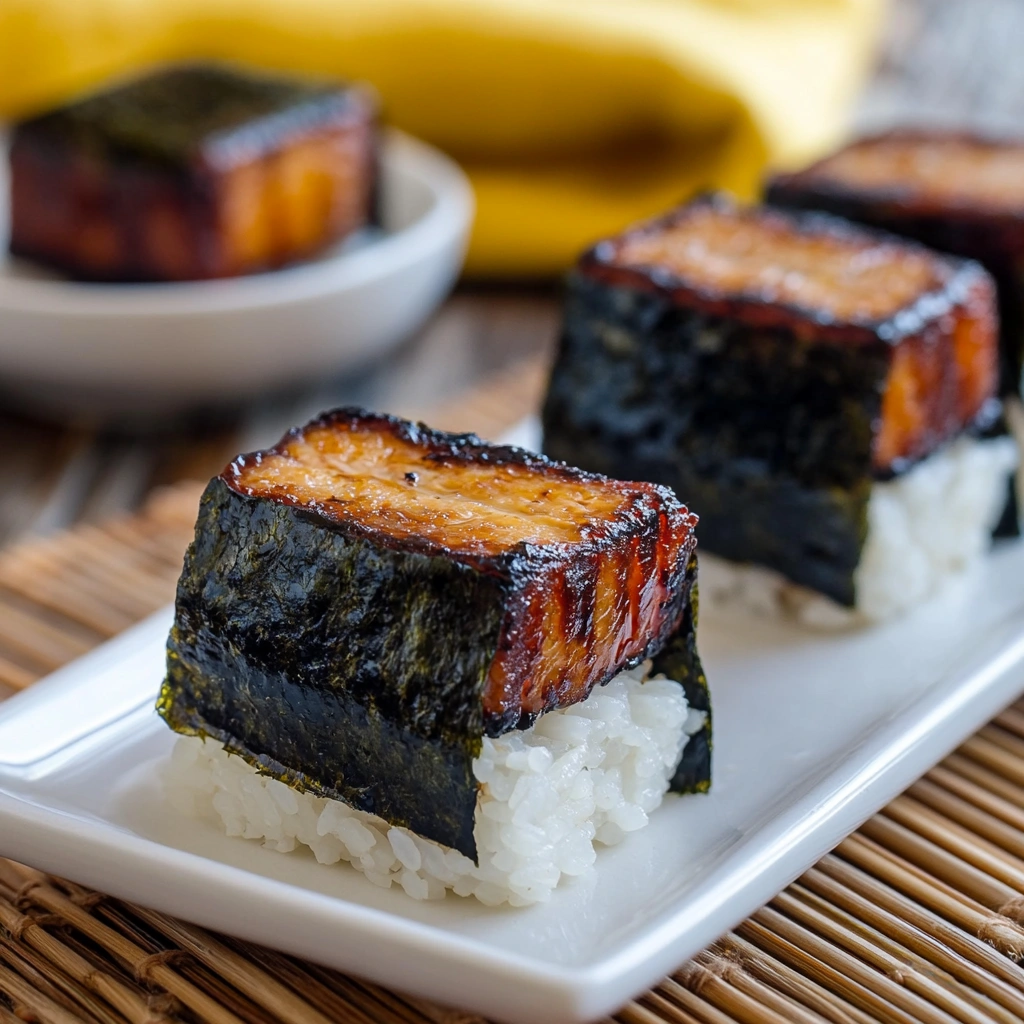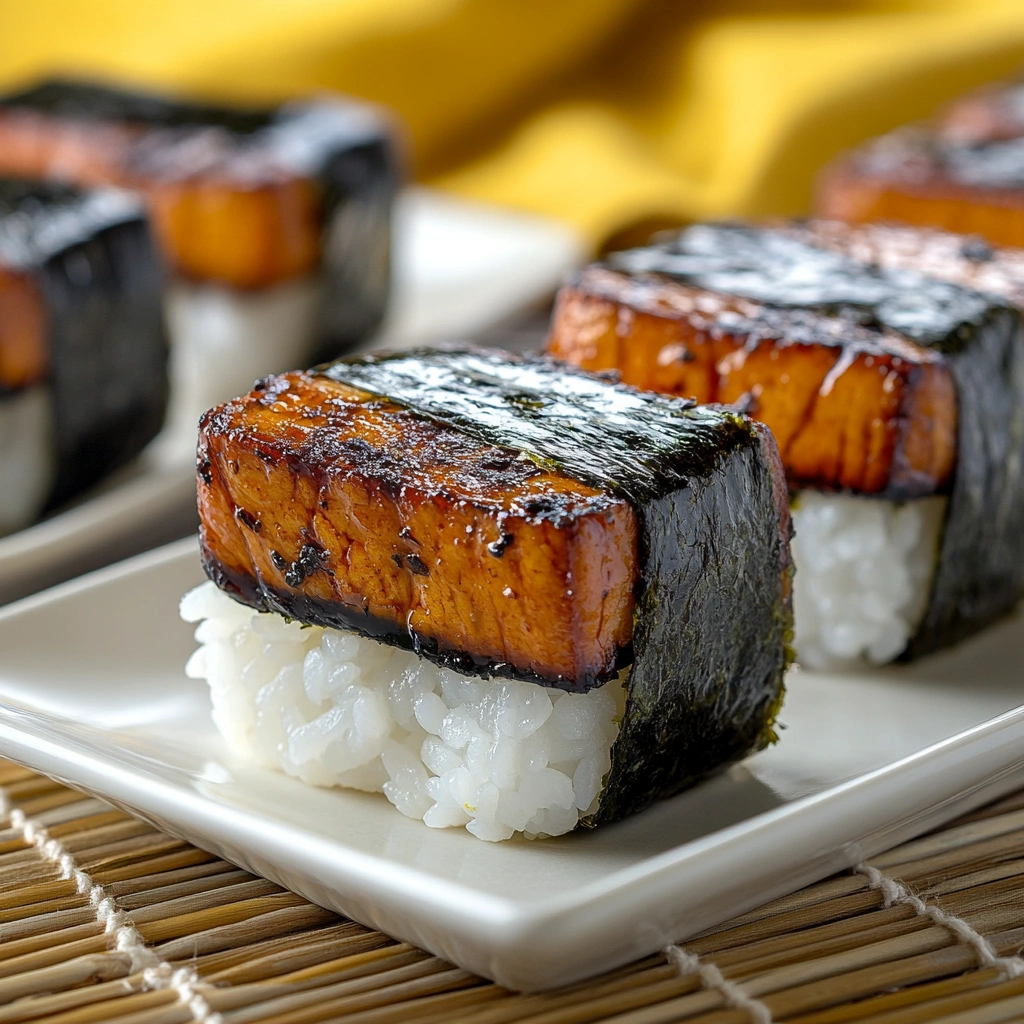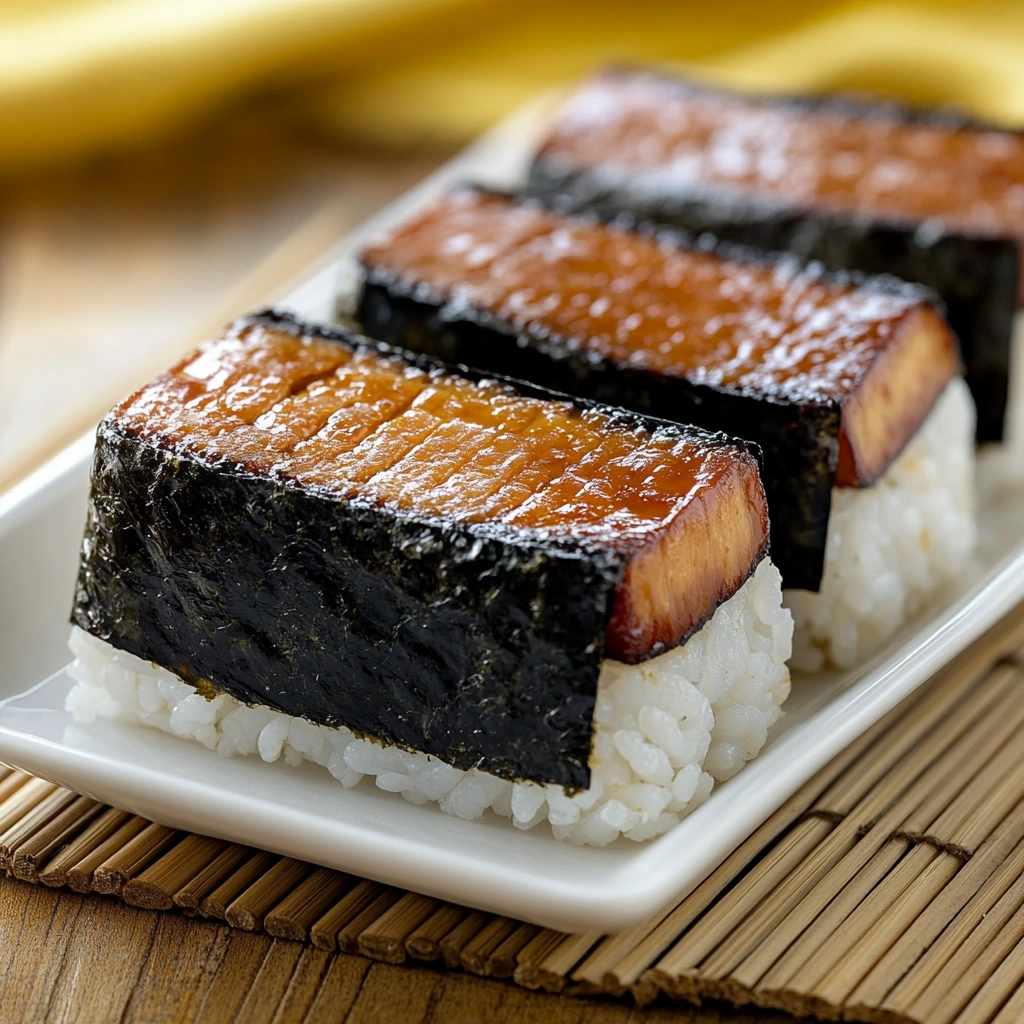Musubi is a dish that has sparked debate over its cultural roots. Some argue that it is uniquely Hawaiian, given its strong connection to Spam and its popularity in local cuisine. Others believe it has Filipino influences, given the similarities to rice-based snacks like suman and kakanin. So, is Musubi Filipino or Hawaiian? To answer this, we need to examine the history, cultural influences, and shared ingredients that define this dish.
This article explores the evolution of Musubi, its Hawaiian roots, its Filipino culinary connections, and how migration and colonization have influenced both cuisines.
For more insights into how food traditions evolve, check out Sinigang Recipe, which showcases another dish shaped by historical influences.
Introduction: The Question – Is Musubi Filipino or Hawaiian?
Why the Debate Exists
The debate over is Musubi Filipino or Hawaiian stems from overlapping food traditions. Both the Philippines and Hawaii share influences from Japan, Spain, and the United States, which have shaped their respective cuisines.
Key reasons for the debate include:
- Japanese Influence: Musubi is derived from onigiri (Japanese rice balls), which spread to Hawaii and Southeast Asia due to Japanese migration.
- Spam’s Role: Spam Musubi is a Hawaiian favorite, but Spam is also widely consumed in Filipino cuisine.
- Rice-Based Snacks: Both the Philippines and Hawaii have traditional rice-based dishes that resemble Musubi.
For a deeper look at how different cultures influence cuisine, check out Ultimate Branzino Recipe Guide, which highlights Mediterranean flavors.
How Food Culture Evolves Through Migration and Influence
Food does not exist in isolation—it evolves through colonization, trade, and migration. The Philippines and Hawaii have histories shaped by Spanish, American, and Japanese interactions, which have significantly impacted their food traditions.
Some examples of cultural food exchanges include:
- Japanese rice balls becoming Spam Musubi in Hawaii.
- Spanish paella influencing Filipino arroz caldo.
- American canned goods, like Spam, becoming everyday staples.
The Significance of Understanding Culinary Heritage
Understanding the origins of food like Musubi allows us to:
- Appreciate how migration shapes cuisine.
- Recognize shared food histories between cultures.
- Preserve authentic traditions while embracing innovation.
For another dish with a rich culinary history, visit Peach Crumble Recipe.
What is Musubi? A Definition Before Asking: Is Musubi Filipino or Hawaiian?
The Basic Components of Musubi
Before asking is Musubi Filipino or Hawaiian, it’s important to understand what it is. Musubi is a rice-based snack, typically made of:
- Rice: Short-grain rice, lightly seasoned.
- Filling: Often Spam, fish, or other proteins.
- Nori (Seaweed): Wrapped around the rice and filling.
Key Characteristics That Define Musubi
What makes Musubi unique?
- Rectangular shape: Unlike round onigiri, Musubi is typically rectangular.
- Portable and convenient: It is designed as a grab-and-go meal.
- Sweet and salty balance: A key element in its flavor profile.
Common Misconceptions About Its Origin
Some people assume that Spam Musubi was invented in Hawaii, but its Japanese origins cannot be ignored. Similarly, Filipino rice dishes share similarities but differ in preparation and presentation.
For another food item often debated in terms of origin, check out Blondie vs. Brookie: Difference.
Hawaiian Roots: Why Some Say Musubi is Hawaiian
Japanese Immigration to Hawaii and Its Impact on Local Cuisine
The Japanese first arrived in Hawaii in the late 19th century as sugar plantation workers. With them, they brought onigiri, the rice ball that later evolved into Musubi. Over time, Japanese ingredients blended with local Hawaiian foods, resulting in:
- The rise of Spam as a common protein source.
- The adaptation of Musubi as a convenient snack for workers and students.
- A distinct flavor profile that differs from traditional Japanese onigiri.
The Role of Spam in Hawaiian Food Culture
Spam is a defining feature of Hawaiian Musubi, largely due to U.S. military presence in the Pacific during World War II. Spam became widely available and integrated into dishes like:
- Spam Musubi: A grilled slice of Spam on seasoned rice, wrapped in nori.
- Loco Moco: Rice, a hamburger patty, a fried egg, and brown gravy.
- Spam Fried Rice: A Hawaiian take on a common Asian dish.
For another dish shaped by war-time food influence, check out Tinis Mac and Cheese, which also evolved from pantry staples.
How Spam Musubi Became an Iconic Hawaiian Dish
Spam Musubi gained popularity because:
- It was portable and easy to eat.
- It combined local and Japanese flavors.
- It became widely available in Hawaiian stores and restaurants.
Over time, Spam Musubi became a symbol of Hawaiian cuisine, though its roots remained tied to Japanese culinary traditions.
Filipino Influences: Is Musubi Filipino or Hawaiian in Terms of Ingredients?
The Role of Rice-Based Snacks in Filipino Cuisine
The Philippines has a strong tradition of rice-based snacks, which raises the question: is Musubi Filipino or Hawaiian?
Some of the most common Filipino rice-based snacks include:
- Suman: Sticky rice wrapped in banana leaves.
- Kakanin: Various rice cakes made with coconut milk and sugar.
- Puto: Steamed rice cakes often served with cheese or salted egg.
These dishes, like Musubi, feature rice as the main ingredient but differ in preparation and flavors.
Similar Filipino Dishes (Suman, Kakanin, and Rice Rolls)
Although Musubi and Filipino rice snacks share similarities, they also have differences:
| Feature | Musubi | Filipino Rice Snacks |
|---|---|---|
| Main Ingredient | Short-grain rice | Glutinous rice |
| Shape | Rectangular | Cylindrical/Round |
| Flavor Profile | Savory-sweet | Often sweet |
How American and Japanese Foods Shaped Filipino Food Traditions
The Philippines was influenced by both American and Japanese cuisine, just like Hawaii. American influence introduced Spam, while Japanese occupation during World War II left a mark on Filipino rice dishes.
For another dish shaped by colonial influences, check out How to Cook and Eat Branzino.

Japanese Origins: The Influence of Onigiri on Musubi
How Musubi Evolved from Japanese Onigiri
One of the strongest arguments in the debate of is Musubi Filipino or Hawaiian comes from its Japanese origins. Musubi closely resembles onigiri, the Japanese rice ball that has been part of Japanese cuisine for centuries.
Onigiri consists of:
- Short-grain rice, often seasoned with salt or soy sauce.
- Fillings such as fish, pickled plum, or tuna mayo.
- Nori (seaweed) used as a wrapper or garnish.
When Japanese immigrants arrived in Hawaii in the late 1800s, they brought onigiri with them. Over time, onigiri adapted to local Hawaiian ingredients, transforming into Musubi.
The Adaptation of Seaweed-Wrapped Rice in Different Cultures
To answer the question is Musubi Filipino or Hawaiian, it is important to note that variations of onigiri-style rice dishes exist across Asia and the Pacific:
- Japan: Traditional onigiri, often served in bento boxes.
- Hawaii: Spam Musubi, incorporating American canned meat.
- Korea: Samgak kimbap, which shares similarities but is seasoned with sesame oil.
While Musubi is deeply connected to Hawaii, its roots in Japanese culinary traditions cannot be ignored.
The Role of Japanese Bento Culture in Portable Food Traditions
Bento culture, emphasizing pre-packed meals, played a major role in how Musubi became a convenient food. The influence of bento culture on Musubi includes:
- Portability: Both onigiri and Musubi are easy-to-carry meals.
- Balanced flavors: A mix of sweet, salty, and umami elements.
- Neat presentation: Often wrapped in seaweed for structure.
For another dish influenced by Japanese food traditions, visit Sinigang Recipe, which showcases the blending of culinary influences.
Spam: The Common Link Between Hawaiian and Filipino Cuisine
Why Spam Became Popular in Both Hawaii and the Philippines
A key factor in the debate of is Musubi Filipino or Hawaiian is Spam’s widespread use in both regions.
Spam became popular due to:
- World War II rationing, when fresh meat was scarce.
- The U.S. military’s presence in the Pacific, which introduced canned goods.
- Affordability and long shelf life, making it a staple ingredient.
Both Hawaiians and Filipinos embraced Spam, incorporating it into daily meals in unique ways.
The U.S. Military’s Impact on Pacific Island Diets
During World War II, canned meats like Spam became widely available in Hawaii and the Philippines. This led to:
- Hawaiians incorporating Spam into Musubi.
- Filipinos using Spam in silog dishes, such as Spam-silog (Spam with garlic rice and egg).
- Spam becoming a symbol of resilience in both cultures.
For another dish shaped by war-time food influence, check out Tinis Mac and Cheese.
How Spam Musubi Fits Into Both Food Cultures
Spam Musubi is a staple in Hawaii, while Spam is widely eaten in the Philippines, though prepared differently.
- In Hawaii: Spam Musubi is an iconic grab-and-go snack.
- In the Philippines: Spam is commonly served in Filipino breakfast meals, rather than as a rice-wrapped dish.
This distinction is key in determining is Musubi Filipino or Hawaiian, as Musubi is rarely found in the Philippines, despite Spam’s popularity.
The Debate: Is Musubi Filipino or Hawaiian Based on Preparation Methods?
Hawaiian-Style Musubi vs. Filipino-Style Rice Dishes
A major factor in answering is Musubi Filipino or Hawaiian is the difference in preparation methods.
Hawaiian-Style Musubi:
- Uses white short-grain rice, lightly seasoned.
- Topped with grilled Spam and wrapped in nori.
- Features a sweet-salty balance, often with teriyaki sauce.
Filipino Rice Dishes:
- Includes suman, kakanin, and rice rolls, using glutinous rice and coconut milk.
- Wrapped in banana leaves, rather than seaweed.
- Primarily sweet, rather than savory.
Differences in Ingredients, Preparation, and Seasonings
A side-by-side comparison of Hawaiian Musubi vs. Filipino rice dishes shows clear distinctions:
| Feature | Hawaiian Musubi | Filipino Rice Dishes (Suman, Kakanin) |
|---|---|---|
| Base | White short-grain rice | Glutinous or sticky rice |
| Seasoning | Soy sauce, sugar | Coconut milk, sugar |
| Wrapper | Nori (seaweed) | Banana leaves |
| Serving | Savory snack | Sweet dessert |
These differences indicate that Musubi is more closely tied to Hawaii, while Filipino rice dishes have a distinct preparation method and cultural background.
For another comparison of culturally similar foods, check out Blondie vs. Brookie: Difference.
The Cultural Meaning Behind Musubi in Both Countries
What Musubi Represents in Hawaiian Culture
Musubi in Hawaii is more than just a snack—it represents:
- A fusion of cultures (Japanese, Hawaiian, and American influences).
- Everyday convenience, as a staple food.
- Resilience, as it originated during war rationing and remained popular.
How Filipinos Incorporate Similar Foods Into Daily Life
While Musubi is not commonly found in the Philippines, Filipino cuisine does share similar rice traditions.
- Rice-based meals are eaten daily, making rice a central food element.
- Sticky rice snacks like suman and kakanin are eaten at celebrations.
- Spam is enjoyed in Filipino breakfast meals (silog dishes) rather than in Musubi form.
For another dish that holds deep cultural significance, check out Sinigang Recipe.
Final Verdict: Is Musubi Filipino or Hawaiian?
The answer to is Musubi Filipino or Hawaiian is Musubi is more distinctly Hawaiian, though influenced by Japanese cuisine.
- Musubi originated in Hawaii, evolving from onigiri and incorporating Spam.
- The Philippines has similar rice-based dishes, but not Musubi itself.
- Musubi reflects Hawaii’s multicultural identity, blending Japanese, Hawaiian, and American traditions.
For a step-by-step guide to making this dish, visit Spam Musubi Recipe.
Global Popularity: How “Is Musubi Filipino or Hawaiian?” Became a Discussion
The Rise of Musubi in Restaurants and Food Trends
The question is Musubi Filipino or Hawaiian gained attention as Musubi became more mainstream beyond Hawaii. Today, Musubi is:
- Sold in specialty Japanese and Hawaiian restaurants worldwide.
- Offered in convenience stores across Hawaii, Japan, and even parts of the U.S. mainland.
- Gaining popularity in fusion cuisine, with chefs experimenting with variations.
Fusion Versions and Gourmet Adaptations
As Musubi’s popularity grows, chefs worldwide have created fusion versions that mix influences from multiple cultures:
- Korean-Inspired Musubi: Features kimchi, gochujang, or bulgogi-style beef.
- Filipino-Inspired Musubi: Includes longganisa, tocino, or adobo-seasoned meat instead of Spam.
- Gourmet Musubi: Uses wagyu beef, foie gras, or even truffle-infused sauces.
For another example of a dish evolving through global influences, visit Ultimate Branzino Recipe Guide.
How Social Media Influences Food Origins and Debates
Platforms like Instagram, TikTok, and YouTube have fueled debates on is Musubi Filipino or Hawaiian by:
- Popularizing Musubi recipes worldwide.
- Highlighting cultural perspectives on food history.
- Encouraging culinary experimentation with different flavors.
Food content creators have played a key role in making Musubi a global conversation piece, leading to more interest in its origins.
Common Misconceptions About Musubi’s Origins
Why People Assume Musubi is Exclusively Hawaiian
Many people believe Musubi is strictly Hawaiian, but this is due to:
- Its association with Spam, which became a key ingredient in Hawaii.
- The lack of Musubi-style dishes in the Philippines, leading people to assume it is only from Hawaii.
- Its presence in Hawaiian gas stations, restaurants, and lunch boxes, reinforcing the idea that it is uniquely Hawaiian.
How Food History is Often a Blend of Multiple Influences
The question is Musubi Filipino or Hawaiian is complicated because many foods have multiple cultural influences. Some examples include:
- Lumpia (Filipino spring rolls), which share similarities with Chinese and Indonesian rolls.
- Pancit (Filipino noodles), influenced by Chinese and Spanish cooking.
- Spam Musubi, which combines Japanese onigiri, American Spam, and Hawaiian adaptation.
For another example of a dish shaped by different cultures, visit Sinigang Recipe.
Why Tracing a Dish’s Origin is Complex
Food origins are rarely black and white, and Musubi’s case is no different. Some key reasons for the complexity of food history include:
- Migration patterns, which introduce ingredients and cooking techniques to new regions.
- Colonization and trade, which influence local food traditions.
- Adaptation based on available resources, such as Hawaii’s use of Spam due to military supply chains.
Understanding food history requires looking at the full picture, rather than assigning a dish to just one culture.
Making Your Own Musubi: Hawaiian vs. Filipino-Inspired Versions
Traditional Hawaiian Spam Musubi Recipe
A classic Hawaiian Spam Musubi is simple to make and requires only a few ingredients:
Ingredients:
- 2 cups cooked short-grain rice
- 1 can Spam, sliced
- 2 sheets nori (seaweed)
- 1 tablespoon soy sauce
- 1 tablespoon sugar
Instructions:
- Fry Spam in a pan, adding soy sauce and sugar for a light glaze.
- Shape the rice into rectangles, matching the size of the Spam slices.
- Place the Spam on top of the rice, then wrap it with a strip of nori.
- Press firmly to hold the shape, then serve warm or at room temperature.
Filipino-Inspired Musubi Variations
While traditional Musubi is Hawaiian, it can be adapted with Filipino flavors:
- Longganisa Musubi: Sweet and garlicky Filipino sausage instead of Spam.
- Adobo Musubi: Chicken or pork adobo-flavored meat with garlic rice.
- Tocino Musubi: Cured sweet pork slices in place of Spam.
Each of these versions uses classic Filipino flavors while following the Musubi structure.
For another Filipino dish that balances sweet and savory flavors, check out Peach Crumble Recipe.
Tips for Perfecting Your Homemade Musubi
- Use short-grain rice for the best texture.
- Press the rice firmly to keep the shape intact.
- Experiment with different proteins to find your preferred variation.
Musubi is versatile and easy to customize, making it a great dish for those looking to try both Hawaiian and Filipino flavors.
Conclusion: So, Is Musubi Filipino or Hawaiian?
Why Musubi is a Fusion of Multiple Influences
The answer to is Musubi Filipino or Hawaiian is Musubi is primarily Hawaiian but influenced by multiple cultures. Key points include:
- Musubi originated in Hawaii, adapting Japanese onigiri into a local favorite.
- The Philippines shares similar rice-based traditions, but Musubi itself is not traditionally Filipino.
- Spam connects both Hawaiian and Filipino cuisine, yet is used differently in each culture.
The Importance of Recognizing Shared Food Heritage
Rather than labeling Musubi as strictly Hawaiian or Filipino, it is important to:
- Acknowledge its Japanese roots, particularly in the form of onigiri.
- Recognize its Hawaiian identity, where it evolved into its current form.
- Appreciate Filipino adaptations, where similar flavors exist, even if Musubi itself is not a traditional Filipino dish.
The Beauty of Cultural Exchange in Cuisine
The discussion of is Musubi Filipino or Hawaiian highlights the way food evolves through migration, adaptation, and shared history.
Rather than focusing on exclusivity, food should be viewed as a bridge between cultures. Musubi reflects how Japan, Hawaii, and the Philippines all contribute to culinary diversity.
For a detailed guide on making Spam Musubi at home, visit Spam Musubi Recipe.
For further reading on Pacific Island cuisine, visit Allrecipes: Hawaiian Food History.


